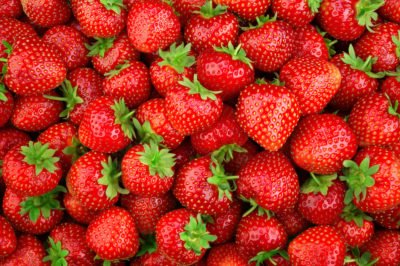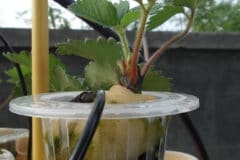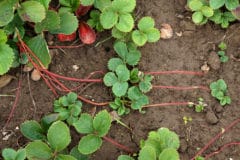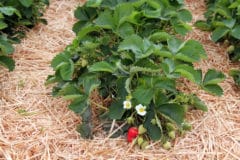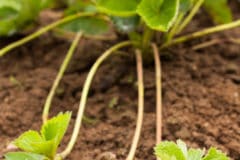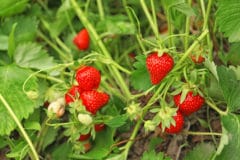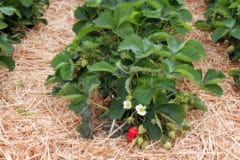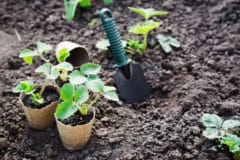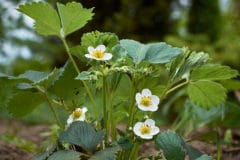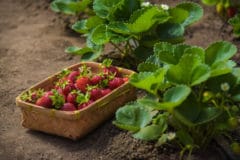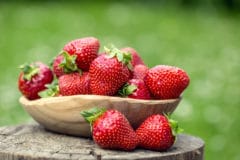Strawberry Types – A Factor in the Harvest Season
The type of strawberry grown is a factor in the duration of the harvest season. Strawberry varieties bear one crop or multiple crops per season. Each type of strawberry also has unique harvest times depending on where and how they are planted.
June Bearing Strawberries
June bearing strawberries planted in the spring will not bear fruit the first season. The following season they should produce one large crop in the summer. Very early fall (August or September) plantings of strawberry plants or roots will not require the removal of the first blossoms; therefore, berries will be picked the first season.
June bearing strawberry plants grown in the coldest USDA Zones will produce one large crop in June. The plants should produce berries for one to three weeks. In longer growing season areas like California, these plants will produce a bountiful crop from April through June. Scattered crops throughout the year will also be produced in these regions.
The varieties of June bearing strawberries can be divided into early, mid-season, and late-season varieties. A growing season can be extended by planting two or more of these varieties that ripen at different times. Here are some varieties and their ripening time:
- Veestar (early season)
- Earliglow (early season)
- L’Amour (mid-season)
- Kent (mid-season)
- Honeoye (mid-season)
- Delmarvel (mid-season)
- Darselect (mid-season)
- Cavendish (mid-season)
- Brunswick (mid-season)
- Allstar (late-season)
- Annapolis (late-season)
- Cabot (late-season)
- Jewel (late-season)
Day-Neutral Strawberries
Many growers choose day-neutral strawberries because of their continuous berry supply throughout the growing season. Unless the temperature is extremely hot (>85°F or 29°C), they will continue to produce fruit, even in the cooler USDA Zones.
The berries of the day-neutral strawberry plants grown in the coldest USDA Zones usually ripen in early June and continue to produce until frost. Harvest during the first season is delayed if the grower chooses to remove the blossoms through the end of June. A fall planting or growing these as annuals eliminate the need to remove blossoms.
Day-neutral strawberries in the warmer zones usually bear the most fruit in the summer and fall. In some areas, picking season is practically all year. Some of the varieties of day-neutral strawberries and where they can be grown are:
- Tribute (USDA Zones 3-10)
- Seascape (USDA Zones 4-7)
- Albion (USDA Zones 4-7)
- Alexandria (USDA Zones 5-8)
- Elan (USDA Zones 5-8)
- Tristar (USDA Zones 4-8)
- Tarpan (USDA Zones 5-8)
Everbearing Strawberries
Everbearing strawberries usually produce a crop of berries in the spring and another one in the fall. They also produce a smaller number of berries throughout the summer. Everbearing strawberries are hardy and similar to wild berries, capable of growing in USDA Zones 2-11. Some everbearing strawberry varieties to try are:
- Ogallala (USDA Zones 5-9)
- Toscana (USDA Zones 4-9)
- Ozark Beauty (USDA Zones 4-8)
- Quinault (USDA Zones 2-9)
- Eversweet (USDA Zones 5-8)
- Fort Laramie (USDA Zones 3-7)
Alpine Strawberries
Many people consider alpine strawberries, commonly called wild strawberries, the best tasting of all the types of strawberries. This three-fourths inch heirloom berry is packed with intense flavor. Alpine berries will bear fruit the first season. The picking season in most areas is continually from June to September. Here are some subtypes to choose from:
- Alexandria
- Mignonette
- Variegata
- Fragola Quattra Stagioni (Italian Four Seasons)
- Fragola di Bosco
- Yellow Wonder
- Yellow Delight
- Baron Solemacher
- Albicarpa (Alba)
- Intensity
- Poziomka
- Holiday
- White Solemacher
- Ivory
- Vesca (two wild forms)
- White Soul
- Regina
- Ever More
- Frost King
- Snow King
- Snovit
Regional Weather- A Factor in Harvest Season
The USDA Hardiness Map is an invaluable tool for giving strawberry growers a general idea of when to plant, but other factors can alter the recommended planting and ripening time. One of these factors is the weather. Strawberry plants flower and fruit in temperatures of 60°F(16°C) to 80°F(27°C). Not every area receives this perfect weather all the time.
Excess rain or unusual cold or hot (in fall planting areas) weather may delay planting which alters the ripening time of the strawberries. When nights are cool and days are warm, strawberries will ripen in about 30 days. Hot, humid weather slows the growth and ripening of strawberries.
Growing and Harvesting Strawberries in Hot Climates
Late spring through fall strawberry picking is typical in temperate zones. In some areas of California, varieties like Hecker can be grown year round and other varieties from April through November. Gardeners in hot climates yearn to taste the sweetness only homegrown strawberries have. Preparation and planting at the appropriate time can make it a reality.
The key to successfully growing strawberries in hot climates is to have the berries ripen in mid-winter. Planting time would have to be in the late summer, followed by four to five months of becoming well-established plants. Strawberry planting in the northern hemisphere would be in September: picking time would be in January.
Hot climate strawberry growers may have a difficult time finding nurseries or garden centers with available plants in the late summer. Friends or neighbors with established plants may have runner plantlets to give.
Altering the Environment
Daytime temperatures of 70°F(21°C) to 80°F(27°C) and nighttime temperatures of 60°F(16°C) to 67°F(19°) typically ripen strawberries in four weeks. Cooler or warmer temperatures may delay the ripening process. Growing strawberries in raised beds or in containers will raise the temperature of the soil. A higher soil temperature will cause the berries to ripen sooner.
Growing Strawberries Indoors
A strawberry picking season can be altered by growing the berries indoors. Gardeners in the colder USDA Zones would benefit by having a longer season. Growers in the hot USDA Zones can grow them in the months that are normally too hot to grow strawberries. Here are two ways of growing strawberries indoors:
Growing in Standard Containers
The compact size of a strawberry plant and their shallow root system make it an ideal plant for container growing. Strawberry plants grown in containers indoors need adequate light. If direct sunlight for six or more hours per day is not possible, a fluorescent light or a compact LED plant light must be used.
Containers must be filled with a light soilless potting mixture and contain a drain hole in the bottom of the container. Like outdoor strawberry plants, indoor grown strawberry plants do not like waterlogged soil. Infrequent deep watering is best for indoor container strawberry plants.
Outdoor strawberry plants usually are pollinated by bees and other insects. Strawberry plants grown indoors must be hand pollinated or there will not be any berries to pick.
Growing in Hydroponic Planters
A hydroponic strawberry planter can be used to grow strawberries indoors. These planters are not filled with soil or soilless potting soil but with a nutrient-rich solution. Unfortunately, most solutions are chemical-based. An advantage of growing strawberries hydroponically is possibly having ripe strawberries year-round.
